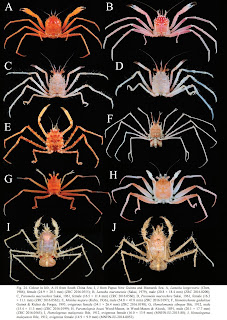 |
| Fig. 24. Homolidae from the South China Sea. Colour in life. A, Lamoha longirostris (Chen, 1986), female (24.9 × 20.3 mm); B, Lamoha murotoensis (Sakai, 1979), male (20.8 × 18.4 mm); C, Paromola macrochira Sakai, 1961, female (16.5 × 11.4 mm); D, Paromola macrochira Sakai, 1961, female (16.3 × 11.1 mm); E, Moloha majora (Kubo, 1936), male (54.8 × 47.8 mm); F, Homolochunia gadaletae Guinot & Richer de Forges, 1995, ovigerous female (34.1 × 26.4 mm); G, Homolomania sibogae Ihle, 1912, male (15.4 × 11.3 mm); H, Paromolopsis boasi Wood-Mason, in Wood-Mason & Alcock, 1891, male (20.1 × 17.7 mm).
Ng & Richer de Forges, 2017. RAFFLES BULLETIN OF ZOOLOGY. 65
|
Abstract
Recent collections from southern Taiwan and the South China Sea obtained 10 species of homolid crabs, of which two species of Homologenus A. Milne-Edwards, in Henderson, 1888, are described as new. The taxonomy of the allied H. malayensis Ihle, 1912, from Indonesia and Papua New Guinea is also clarified. The identity of Lamoha superciliosa (Wood-Mason, in Wood-Mason & Alcock, 1891) s. str. from the Indian Ocean is discussed and specimens from East Asian seas that had been referred to this species are here shown to be conspecific with L. longirostris (Chen, 1986) instead. The taxonomy of L. superciliosa and L. longirostris is treated.
Key words. Taxonomy, new species, South China Sea, deep sea, homolid crabs, Homologenus
Homologenus exilis n. sp.
Etymology. From the Latin “exilis” meaning “thin or slender”, alluding to the relatively long ambulatory legs of the species when compared to the other new species, H. brevipes. Used as a noun in apposition.
Homologenus brevipes n. sp.
Etymology. The name alludes to the relatively shorter ambulatory legs of this species when compared to those of the allied new species, H. exilis. Used as a noun in apposition.
Peter K. L. Ng and Bertrand Richer de Forges. 2017. On A Collection of Homolidae from the South China Sea, with Descriptions of Two New Species of Homologenus A. Milne-Edwards, in Henderson, 1888, and the Identities of Homologenus malayensis Ihle, 1912, and Lamoha superciliosa (Wood-Mason, in Wood-Mason & Alcock, 1891).
RAFFLES BULLETIN OF ZOOLOGY. 65: 243–268.
RAFFLES BULLETIN OF ZOOLOGY. 65: 243–268.


